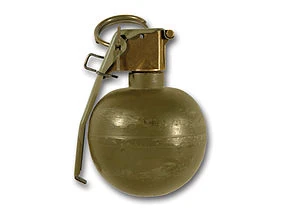The M67 grenade is a fragmentation hand grenade used by the United States military. The M67 is a further development of the M33 grenade, itself a replacement for the M26-series grenades used during the Korean and Vietnam Wars, and the older Mk 2 "pineapple" grenade used since World War II. The M67 hand grenade has an effective casualty radius of about 15 meters (49 feet).

Overview[]
The M67 grenade has a spherical steel body that contains 6.5 oz (180 g) of composition B explosive. It uses the M213 pyrotechnic delay fuse. The M67 grenade weighs 14 oz (400 g) in total and has a safety clip to prevent the safety pin on the grenade from being pulled accidentally. The safety pin prevents the safety lever, or "spoon" on the grenade from moving and releasing the spring-loaded striker which initiates the grenade's fuse assembly.
The M67 can be thrown 30 to 35 meters (98 to 115 ft) by the average male soldier. Its fuse delays detonation between 4 and 5 seconds after the spoon is released. Steel fragments (not to be confused with shrapnel) are provided by the grenade body and produce an injury radius of 15 meters (49 ft), with a fatality radius of 5 meters (16 ft), though some fragments can disperse as far out as 250 meters (820 ft).
Use[]
To deploy the M67 grenade, the user first removes the safety clip from the grenade.
Next, the grenade's pull ring is grasped with the non-throwing hand while maintaining a firm grasp on the body of the grenade and safety lever (also referred to as the "spoon") with the throwing hand. The pull ring and safety pin assembly are fitted so that a right-handed thrower can grasp the grenade with the fuse assembly on top and the safety lever held down by the right thumb. A left-handed thrower should grasp the grenade with the fuse assembly on the bottom and the safety lever held down by the left thumb.
The user then pulls the grenade and pull ring assembly apart, removing the safety pin from the fuse assembly. At this time, the fuse remains unfired, as the throwing hand's thumb is holding the safety lever down.
The user then throws the grenade at the intended target, taking care that the grenade does not strike an obstacle that could deflect the grenade, bounce it back towards the thrower or allow it to roll towards the thrower or an unintended place. When the grenade is thrown, the safety lever will fly free (under pressure from the striker spring) and the striker will hit the cap, igniting the pyrotechnic delay element. When the delay element has burned approximately 4 to 5 seconds it will initiate the grenade's explosive filler, causing a large number of metal fragments to be projected at high velocities. The thrower and friendly personnel in the vicinity should take cover to protect themselves from unintended injury.
Variants[]
M33 Fragmentation Grenade[]
The M33 was the original successor to the M26 fragmentation grenade. It was essentially identical to the M67, but lacked the safety clip that is fitted to the safety lever of the M67.
M68 Fragmentation Grenade[]
This is a variant of the M67 fitted with the M217 impact fuse and a safety clip on the safety lever. This fuse has an electrical impact function which arms within 1 to 2 seconds and will detonate the grenade upon impact, and a back-up pyrotechnic delay function which will initiate the grenade after 3 to 7 seconds if the impact function fails. The M68 has the same statistics and markings as the M67 except it has a red-painted fuse and lever to indicate it has an impact fuse.
M33A1 and M59 Fragmentation Grenades[]
Predecessors to the M68, these impact fused grenades used the M33 grenade body fitted with the M217 impact fuse, without a safety clip on the safety lever, and are marked in a similar manner to the M68.
M69 Practice Grenade[]
The M69 grenade is used for grenade training to safely simulate the M67 grenade. The fuse screws into the body, and is replaceable after use. The simulator produces a report and small puff of white smoke when properly employed.
The M69 has a blue-painted lever and a blue body. This is to indicate that it is a safe practice grenade rather than a live fragmentation grenade like the M33 or M67